Analyzing Record China through the Structural Topic Model
Wu Tung-Wen
(Data scientist at Service Development Group, dip Corp.)
March 7, 2024
*This paper reflects opinion of the author as derived from an analysis using quantitative political science and data. It does not represent the views of the organization to which this author belongs.
Introduction
This paper utilizes text data from the years 2021 and 2022 obtained through web scraping, provided by Professor Maiko Ichihara (Hitotsubashi University), focusing on the online news outlet “Record China.” Building on Ichihara’s observation that China potentially influences the operation of Record China,[1] this paper aims to analyze the discourses that China seeks to propagate in Japan.
This paper employs the Structural Topic Model (STM), one of the methodologies of Text as Data in political science. By leveraging STM, it becomes possible to visualize how variables such as the source and timing of content delivery impact the likelihood of certain topics being addressed. This enables a more nuanced examination of the strategic considerations underlying the site’s operation.
However, given the extensive nature of results from large-scale Bayesian models like topic models, attempting to comprehensively interpret all outcomes would exceed the scope of this paper. Consequently, the paper narrows its focus to analyze aspects wherein Record China emphasizes the negative relations between Japan and South Korea, and China’s economic and technological advantages.
Data Description
Professor Ichihara has provided approximately 30,000 pieces of data obtained through web scraping. This dataset encompasses all articles published by Record China from 2021 to 2022. Upon examining the fluctuation in the volume of articles, it is discernible that, at least over the two-year period of 2021 and 2022, Record China consistently published around 20 to 60 articles per day, suggesting stability in its operation.
Figure 1: Distribution of the number of Record China articles
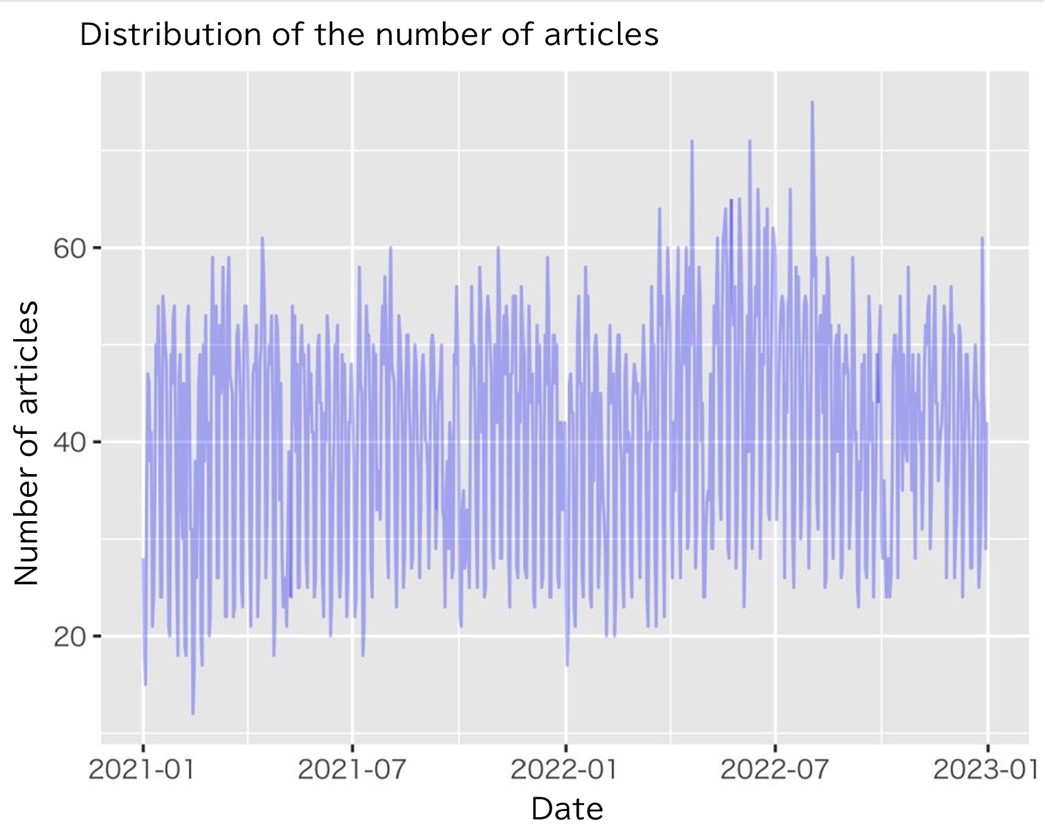
Source: Created by the author.[2]
A large number of articles in Record China are reprints of articles published by other media. Subsequently, the next step involves examining the distribution of citations indicated below the article titles on the Record China website. Given the complexity of visualizing all sources, including articles authored by individuals, the analysis focuses on visualizing the top 10 sources with the highest article volume.
Figure 2: Distribution of citations
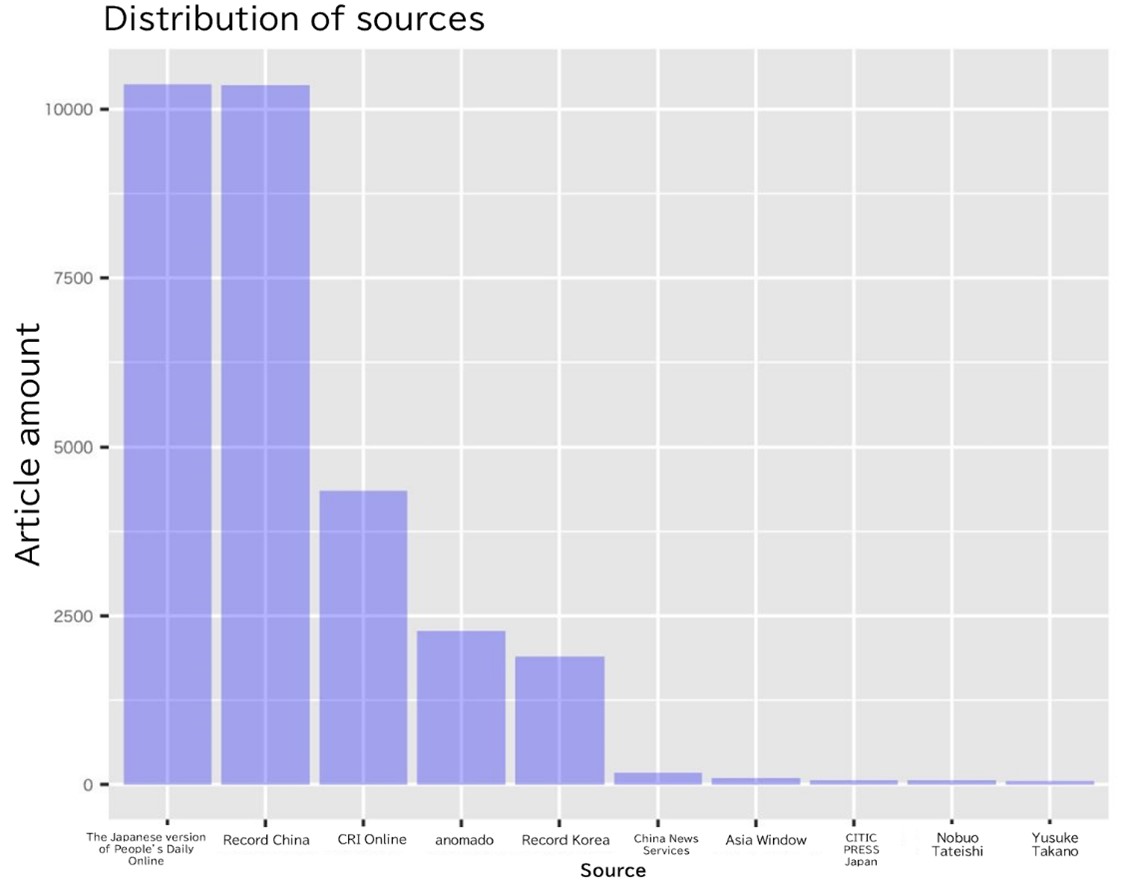
Source: Created by the author.
As evident from the figure, the majority of the approximately 30,000 scraped article data can be attributed to articles that either originated from Record China itself or were republished from the Japanese edition of People’s Daily. Consequently, this paper narrows down the analysis to sources exclusively from Record China and the Japanese edition of People’s Daily.
Methodology
What is LDA?
As mentioned earlier, this article employs STM for analysis. This section explains what topic models are in the first place.
The topic model is fundamentally derived from the Latent Dirichlet Allocation (LDA) method that David Blei and colleagues proposed in their 2003 paper.[3] The underlying concepts are roughly the same. Therefore, this article begins by explaining the fundamental way of thinking in LDA.
LDA assumes that documents can be represented as proportions of multiple topics, where each topic has different probabilities of word occurrence. The model automatically estimates and learns the proportions of each topic in each document, as well as the probabilities of word occurrence for each topic. For instance, consider a political science paper that discusses methodology for 40% of its content while explaining history and background for the remaining 60%. In terms of topics, the methodology topic may have relatively high probabilities of occurrence for words such as “significance,” “identification strategy,” and “prior distribution,” whereas the history topic may have high probabilities of occurrence for specific events or actor names.
In addition to documents and topics, LDA also makes assumptions about the generation of words within a document. First, it extracts a topic from the proportions of topics in the document. Subsequently, it extracts words based on the probabilities of word occurrence associated with that extracted topic.
What is STM?
Building upon the preceding explanation, this section delves into the explanation of STM,[4] which is employed in this paper.
In addition to the basic structure of LDA described above, STM has two other covariates: prevalence covariate and content covariate. The prevalence covariate is a variable that affects the likelihood of a topic being mentioned. For example, it represents the fact that legislators who are interested in agriculture talk about agricultural topics more than others. A content covariate is a variable that visualizes differences in the way the content is talked about in the first place. In a straightforward example, the Ukrainian and Russian media would emphasize different content on the same topic of the Ukrainian-Russian conflict. However, an STM that does not specify the content covariate, or traditional LDA would result in a “Ukrainian version of the Ukraine-Russia conflict topic” and a “Russian version of the Ukraine-Russia conflict topic.” By incorporating the content covariate into the STM, the model can merge the “Ukrainian version” and the “Russian version” into a single “Ukraine-Russia conflict topic” and visualize the differences between Ukrainian and Russian narratives within that topic.
Data Description
In this section, the data are put into STM for analysis. As mentioned earlier, among the data provided by Professor Ichihara, the analysis here covers articles written by reporters from Record China and reprinted from the Japanese version of the People’s Web site. As for the processing of Japanese, everything other than hiragana, katakana, kanji, and romaji was replaced with spaces. Next, only nouns are left using mecab via RMeCab, tokenization and document matrices are created using R’s text data processing package quanteda, and finally “の” (“of” in English) and other words with particularly high and particularly low frequency of occurrence are removed. After this process, the remaining data is submitted to STM.
When using STM it is necessary to specify the number of topics, which is set as 60 in this analysis. For the prevalence covariate, the source name (Record China or the Japanese version of People’s Daily Online) and the month are set. The content covariate is not specified. All other parameters conform to the default settings in the STM package.
Overview
The first step is to overview the estimated results. Figure 3 shows the representative words for each of the 60 topics and the percentage each occupies in the overall data set.
Figure 3: Distribution of Topics in STM

Source: Created by the author.
From this figure, it can first be pointed out that the topic with the highest percentage in the data from Record China, provided by Professor Ichihara, is Topic 24. Its content is related to voices on the Internet. Figure 4 below shows the representative words of Topic 24 in word cloud format to examine the details of Topic 24.
Figure 4: Word cloud for Topic 24 (Voices on the Internet topic)
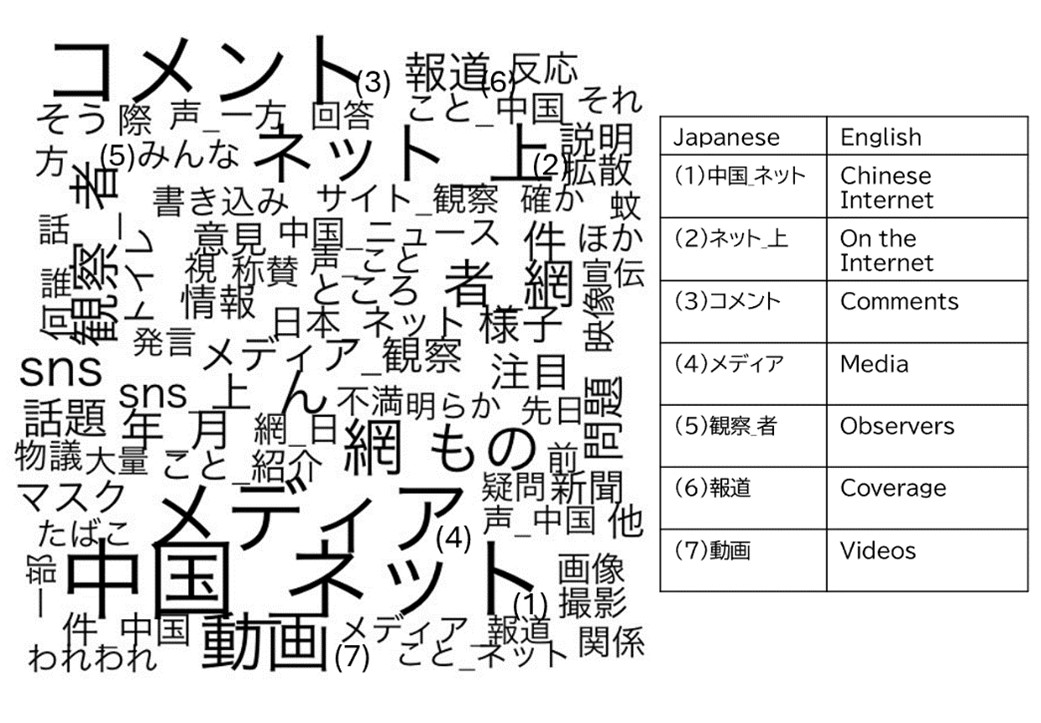
Source: Created by the author.[5]
The larger the letters in this word cloud, the more representative the word is in this topic. From Figure 4, it is indeed possible to identify words such as “ネット_ユーザー(Internet user),” “インターネット(Internet),” and “声(voices).” It is assumed that Record China’s emphasis on voices on the Internet is the reflection of the operator’s intention to make it more relatable to the viewers and to facilitate the spread of discourse.
The model estimates 60 topics, and these include a wide variety of content, such as U.S.-China relations and Taiwan-related topics. Since it is not possible to go into depth on all the topics due to space limitations, as mentioned in the Introduction, the following sections will discuss topics related to Japan-Korea relations and China that may be of particular interest to readers.
Discourse regarding Japan-Korea Relations
First, interestingly, Record China, despite its site name, publishes articles related to the comfort women issue and the Rising Sun Flag. Furthermore, as can be read from Figure 3, neither Topic 4 related to the comfort women issue nor Topic 54 related to the Rising Sun Flag are small in proportion in the data set. Therefore, it can be hypothesized that the operators of Record China are intentionally trying to emphasize Japan-Korea relations, as represented by the comfort women issue and the Rising Sun Flag issue.
A detailed review of the content related to these two issues is given below.
Comfort Women Issue
First, a word cloud is created for Topic 4 related to the comfort women issue, to visually grasp the content.
Figure 5: Word cloud for Topic 4 (Comfort women issue topic)
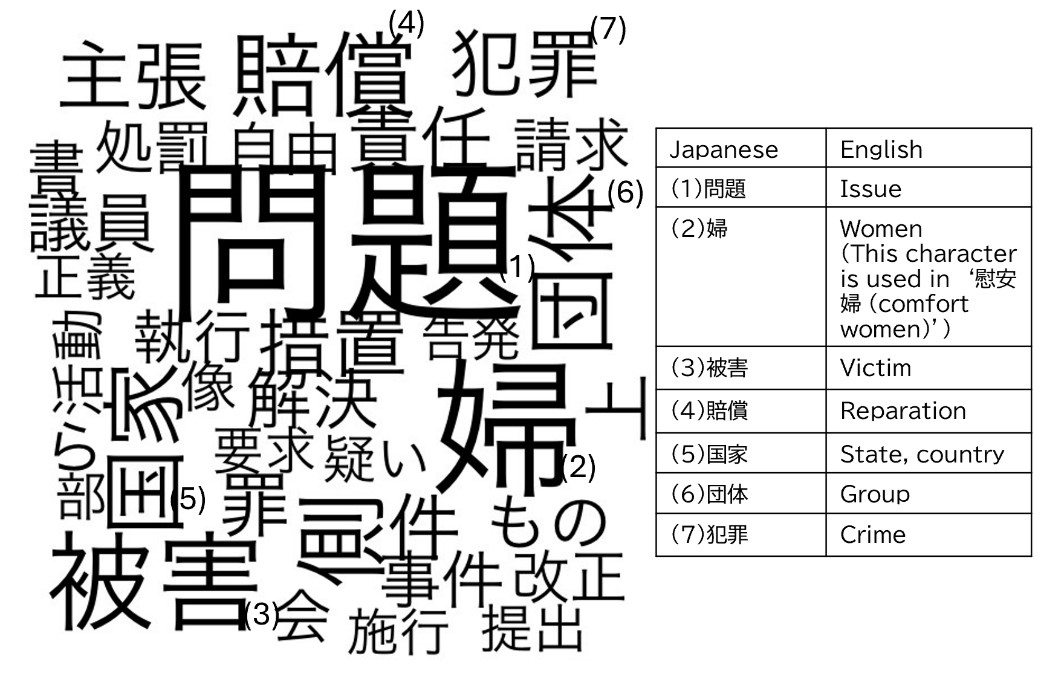
Source: Created by the author.
When the prevalence covariate is checked, the coefficient for the Japanese version of the People’s Daily Online is -0.024061 and 0.1% significant, so it can be concluded that Record China is more likely to cover this topic than the Japanese version of the People’s Daily Online. Since the month is also included in the model as a diffusion covariate, the probability of coverage of Topic 4 in each month can be visualized as follows.
Figure 6: Shift in Expected Proportion of Topic 4 (Comfort women issue topic)
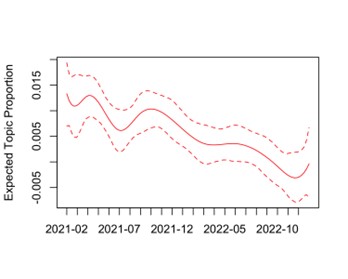
Source: Created by the author.
From Figure 6, it can be read that the probability of coverage of Topic 4, the expected proportion of the comfort women issue, is trending downward.
The focus then shifts to one part of the Record China article.[6]
On June 15, 2021, the Seoul Central District Court ordered the Japanese government to disclose an inventory of its assets held in South Korea over a ruling by the Seoul Central District Court ordering the Japanese government to compensate former comfort women, according to the JoongAng Daily News, South Korea. According to the article, Judge Kim Jong-gon ordered the Japanese government to pay 100 million won (approx. 9.8 million yen) to each of the 12 former comfort women in a lawsuit filed by them in January of this year. The Japanese government, which claims “sovereign immunity” under international law, which states that a nation is not subject to the jurisdiction of other nations, did not appeal, and the ruling became final. The comfort women filed an “application for clear statement of property” with the district court to enforce the order.[7]
Record China also published the following article.[8]
On August 27, 2021, the so-called “Yoon Mi-hyang Law,” a controversial law that included strict penalties for “fact-pointing defamation” against organizations related to former comfort women, was withdrawn, according to Digital Times, Korea. On 13, Yoon Mi-hyang (independent), former president of the former comfort women support group The Korean Council for Justice and Remembrance for the Issues of Military Sexual Slavery by Japan (Korean Council), and In Jae-keun, a member of the ruling Democratic Party of Korea, jointly proposed a bill named “an amendment to the Act on Protection, Support and Commemorative Projects for Sexual Slavery Victims for the Japanese Imperial Army.”[9]
Thus, articles of Record China include stories of former comfort women and content related to the protection and support of former comfort women.
Rising Sun Flag
For the 54 topics related to the Rising Sun Flag, a word cloud is also created to first visually grasp the content.
Figure 7: Word cloud for Topic 54 (Rising Sun Flag topic)

Source: Created by the author.
Checking the prevalence covariate, the coefficient for the Japanese version of the People’s Daily Online is -0.033791 and 0.1% significant. In other words, as with the comfort women topic, the Rising Sun topic is a topic that Record China tends to cover more than the Japanese version of the People’s Daily Online. It is interesting to note that Record China, which by its name seems to be a media outlet specializing in China, covers more content emphasizing the deteriorating Japan-ROK relations than the Japanese version of the People’s Daily Online. However, it is possible that for some reason Record China refrains from reproducing articles from the Japanese version of the People’s Daily Online that emphasize negative Japan-ROK relations, so it is worth additional analysis to see if the same trend would emerge if articles from the Japanese version of the People’s Daily Online that have not been reproduced were included.
Next, monthly coverage of Topic 54 is visualized.
Figure 8: Shift in expected proportion of Topic 54 (Rising Sun Flag topic)

Source: Created by the author.
As with the comfort women topic, there is a downward trend in the overall proportion.
Next, a partial review of the content of the article[10] on the Rising Sun topic reveals that it uses the strong phrase “war criminal flag (戦犯旗),” although it is a quote from a university professor’s statement.
On October 15, 2021, Sungshin Women’s University professor Seo Kyoung-Duk, who works in public relations in South Korea, revealed on a social networking site that he sent an e-mail protesting the use of the “Rising Sun Flag” on the official website of the British world-famous rock band Led Zeppelin. According to Professor Seo, Led Zeppelin’s official website is currently selling T-shirts commemorating the 50th anniversary of the band’s first concert in Japan in 1971, and the background of the website and the T-shirt design use the Rising Sun Flag. In response, Professor Xu explained that “the Rising Sun Flag is a military flag used by the Japanese army during the Pacific War and is a ‘war criminal flag,'” and that “using the war criminal flag on the website and T-shirt design is an act that hurts many Asian fans.” “I hope you will correct this immediately and set a good precedent for your fans around the world as a world-class pop star.”[11]
The following article[12] also describes the Rising Sun Flag as a “war criminal flag.”
On April 29, 2021, according to a report by South Korean Sports Today, Professor Seo Kyoung-Duk from SungShin Women’s University, involved in public relations activities, criticized Canadian singer Justin Bieber for wearing a “Rising Sun Flag costume.” The article mentions that Justin appeared on the “Music Station (Mステ)” broadcast on the 9th of this month, wearing a down jacket from the U.S. fashion brand “ERL” featuring a sunrise motif. This attire sparked controversy in South Korea as it was deemed reminiscent of the Rising Sun flag. In response to this, Professor Seo revealed on his social media on the 29th that he had sent a protest email to Justin’s SNS account and management agency, explaining, “The Rising Sun Flag is a war criminal flag with the same meaning as the swastika. Many people in the West are unaware of it.” He also urged Justin to learn the historical significance of the Rising Sun Flag through this incident and never repeat such actions, calling for a sincere apology to Asian fans.[13]
Ichihara points out that China is trying to spread negative discourses about Korea in Japan.[14] The fact that this paper, which employs different methodology and data, finds a similar phenomenon indicates that this hypothesis is adequately plausible.
Discourses related to China
Although possibly caused by the timing as the data is limited to the 2021–2022 period, the coverage related to China contrasts sharply with that on Japan-ROK relations. Topics regarding China tend to focus on China’s role in promoting softer tourism, cooperation among states, and China’s economic and technological advances. As a result, negative Japan-China relations and the challenges they face are seldom covered.
International Cooperation
Topic 28 emphasizes international cooperation. The word cloud below visualizes it.
Figure 9: Word cloud for Topic 28 (International cooperation topic)

Source: Created by the author.
Confirming the prevalence covariates, the coefficient for the Japanese version of the People’s Daily Online is 0.015268 and 0.1% significant. In other words, unlike the topics introduced above that emphasize the negative Japan-ROK relations, the Japanese version of the People’s Daily Online emphasizes China’s role in international cooperation. While Figure 10 visualizes the shift in the monthly expected proportion of the topic, a clear pattern cannot be observed.
Figure 10: Shift in expected proportion of Topic 28 (International cooperation topic)

Source: Created by the author.
A part of an article[15] related to the international cooperation topic includes discourses that emphasize the importance of international cooperation, such as the UN Charter and multilateralism. This may indicate China’s willingness to become a leading actor in the international community, like the United States.
At the suggestion of China, which holds this month’s rotating presidency of the United Nations Security Council, the Security Council held a high-level meeting on “Upholding multilateralism and the UN-centered international system” in an online format on August 7. The meeting was chaired by Wang Yi, Chinese State Councilor and Minister of Foreign Affairs, Xinhua reported. Wang noted, “Last September, President Xi Jinping attended a series of high-level meetings to commemorate the 75th anniversary of the founding of the UN, where he gave an in-depth interpretation of multilateralism and clearly pointed out that the path of multilateralism should be upheld. He added, “The UN is the banner of multilateralism. Adherence to multilateralism requires maintaining the basic rules of international relations with the purpose and principles of the UN Charter as the cornerstone, maintaining the authority and status of the UN, and maintaining the core role of the UN in international affairs.”[16]
The following article[17] also includes similar discourses. The article uses terms such as, among others, preventing a reverse trend of decoupling, defender of multilateralism, and contributor to world development. Thus, it can be interpreted as an attempt to express that China seeks to be, or already is, a superpower that maintains international cooperation instead of the United States.
On April 21, Chinese State Councilor and Minister of Foreign Affairs Wang Yi held a televised meeting with German Foreign Minister Maas. Wang said, “Since last year, China-Germany relations have maintained overall stability. As comprehensive strategic partners, China and Germany have always firmly maintained the important principles of mutual respect and valuable know-how, adhered to the main tenets of dialogue and cooperation, and sent out a positive message of cooperation, mutual benefit, and win-win to the outside world. Both sides should work together to prevent the reverse trend of so-called “decoupling” and be advocates of multilateralism and contributors to global development.” Foreign Minister Maas said, “Germany attaches great importance to its relations with China and hopes to promote dialogue in all areas, strengthen practical cooperation, and jointly address global problems and challenges.”[18]
Economic and Technological Developments
Since several topics emphasize economic development, ranging from Topic 41 (China’s innovation policy topic) to Topic 23 (China’s medical technology topic), Topic 19 (China’s innovation topic), and Topic 55 (Economic situation in China and Asia topic), space limitations here prevent the results from being as detailed as those for other topics. First and foremost, however, it is important to emphasize that the coefficients for Topic 41, Topic 23, Topic 19, and Topic 55 are all positive for the Japanese version of the People’s Daily Online, and the Japanese version of the People’s Daily Online is more likely to cover economic and technological developments in China than Record China. This shows that the site operators use the Japanese edition of the People’s Daily Online and Record China for different purposes and with different criteria.
Let us begin with Topic 41.
Figure 11: Word cloud for Topic 11 (China’s innovation policy topic)
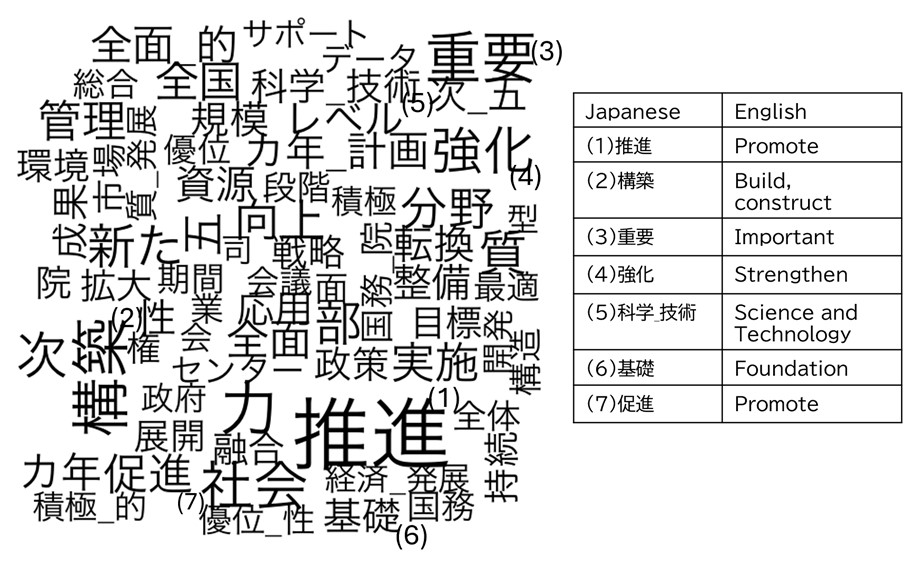
Source: Created by the author.
Taken together with the actual content, it is clear that this is a topic that is a compilation of articles[19] on the direction of innovation-related policies of the Chinese government.
The “Guidelines for Building a Powerful Intellectual Property Country (2021-2035)” issued by the Communist Party of China Central Committee and the State Council were announced on the 22nd. Policies for accelerating the construction of an Intellectual Property Rights (IPR)-strong country have been set in place, Xinhua reported. The charter points out that “the construction of a world-class IPR powerhouse with Chinese characteristics is of great significance in enhancing the nation’s core competencies, expanding the high level of foreign opening, achieving higher quality, more efficient, fairer, more sustainable, and more secure development, and meeting the growing needs of the people for a better quality of life.” The report noted that “by 2025, IPR will be a major source of income for the country’s citizens. By 2025, China will have made significant achievements in building an IPR powerhouse, achieving stricter protection of IPRs, maintaining a high level of social satisfaction, further clarifying the market value of IPRs, and significantly enhancing brand competitiveness. By 2035, China will be at the world’s top level in the comprehensive competitiveness of IPR, and will basically complete the establishment of a world-class intellectual property powerhouse with Chinese characteristics.”[20]
Next, regarding Topic 23, it is clear that this topic is related to medical technology, as it contains keywords such as genes.
Figure 12: Word cloud for Topic 23 (China’s medical technology topic)
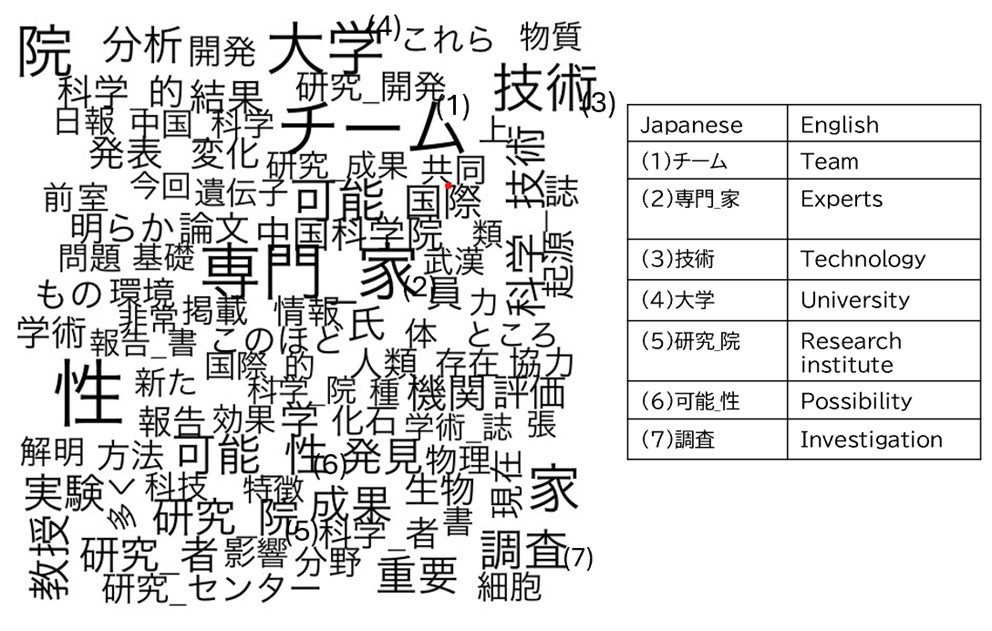
Source: Created by the author.
Viewed together with the articles, it is clear that this topic is a compilation of articles on the direction of innovation-related policies of the Chinese government. The author is not a medical expert and avoids detailed evaluation, but the way the article[21] related to Topic 23 introduces advanced technologies is found impressive.
Wuhan University revealed on April 10 that researchers at the university’s Zhongnan Hospital have discovered that a certain lysosome-associated protein (TMBIM1) has a key negative regulatory role on adipogenesis. This is a potential molecular target to treat obesity-related metabolic disturbances. The study was published online in Cell Metabolism, a top international journal in the field of metabolism, on August 8, Science and Technology Daily reported. The study analyzed transcriptome data of mouse and human progenitor adipocyte differentiation by bioinformatics means and found significant changes in the expression of TMBIM1 in adipocyte differentiation. The study demonstrated that TMBIM1 functions to inhibit adipocyte differentiation in an in vitro progenitor adipocyte differentiation model.[22]
Next up is Topic 19, which addresses artificial intelligence and other innovations in China.
Figure 13: Word cloud for Topic 19 (China’s innovation topic)

Source: Created by the author.
As the content of the article below[23] indicates, this topic is primarily intended to showcase the advanced technology that China possesses.
With some sounds, figures and Chinese characters such as “虹拓” and “中国光谷” appear in the air, visible to the naked eye and touchable by hand. This is a science fiction-like scene that unfolded at the Hongtu Ultrafast Laser Joint Laboratory in the Wuhan Donghu New Technology Development Zone on March 19. According to Cao Xiangdong, head of the laboratory, the peak power density of the team’s newly researched and manufactured high-energy, high-peak-power femtosecond laser device is in the 1 million MW class and can collect “the fastest light” in bundles and brighten the air, Science and Technology Daily reports.[24]
Finally, attention is directed to a topic related to economic situations in China and Asia.
Figure 14: Topic 55 (Economic situations in China and Asia topic)

Source: Created by the author.
A look at the article[25] related to Topic 55 reveals that some content emphasizes the economic downturn in the U.S. and Europe and the economic influence of the Asian region, while other content presents figures.
The Organization for Economic Cooperation and Development (OECD), in its Economic Outlook released on April 22, put forward a forecast for global economic growth to be 3.1% in 2022, slowing to 2.2% in 2011, and 2.7% in 2012, Xinhua reported. According to the Outlook, global economic growth is expected to slow further over the next year as energy problems created by the Ukraine crisis continue to stimulate inflation and increase global risks. The Outlook states, “the major Asian emerging-market economies and regions will account for close to three-quarters of global gross domestic product (GDP) growth in 2023. Economic growth rates in the United States and Europe are slowing sharply. Annual growth in the U.S. is 1.8% this year and will decline to 0.5% next year. Annual growth in the euro area in 2023 is expected to be 3.3% this year and 0.5% next year, while the annual growth in the UK is expected to be 4.4% this year and turn negative next year to -0.4%,” the report predicts.[26]
It also includes the following article[27] related to Topic 55.
The International Monetary Fund (IMF) released its latest World Economic Outlook (WEO) on June 6. China’s economy is projected to grow 8.4% in 2021, up 0.3 percentage points from the January forecast, Xinhua reported.[28]
The study by Professor Ichihara also points out the phenomenon of China using the media to propagate the attractiveness of China.[29] Therefore, the findings of this paper are similar to those of Professor Ichihara’s study, not only in regard to Korea but also in regard to China. It can be concluded that China’s attempts to spread discourse in Japan related to the negative aspects of Japan-Korea relations and the positive aspects of China is likely to be a general phenomenon that transcends specific time periods and media.
Conclusion
This article employs STM to analyze Record China articles to identify the following two phenomena. First, while Record China appears at first glance to be a website that presents information mainly about China, it instead focuses on Korea-related issues, especially the negative aspects of Japan-Korea relations. The second phenomenon that should be reiterated in the conclusion is that while Record China, especially articles whose source is the Japanese version of People’s Daily Online, emphasizes the positive aspects of China, it does not present the problems in Japan-China relations as it does for Japan-Korea relations. This likely reflects a specific strategy of the site operator.
The limitations of the analysis in this paper should also be emphasized here. Since the data obtained from Professor Ichihara cover only two years, 2021 and 2022, it is not possible to determine whether what is revealed in the STM analysis is a trend of Record China or a coincidence of these two years. To solve this problem, adding the period to the data allows analyzing how Record China reported on Japan-China relations during the past extremely deteriorated period of Japan-China relations. However, the analysis by Ichihara[30] using data from 2019 verified similar results and thus the findings of this paper have some validity. Additionally, it is expected that adding other information, such as other major national newspapers in Japan, to the analysis would enable more precise study in the future.
【Translated by】
Takahiro NAKAJIMA
(Bachelor’s student, Faculty of Law, Hitotsubashi University)
[1] Ichihara Maiko. “Is Japan Immune from China’s Media Influence Operations?” The Diplomat (2020). (https://thediplomat.com/2020/12/is-japan-immune-from-chinas-media-influence-operations/ Accessed on 2023-1-19). [2] Translator’s note: Figures 1 and 2 contained Japanese words, which were translated and modified by the translator. [3] David M. Blei, Andrew Y. Ng, and Michael I. Jordan, “Latent dirichlet allocation.” Journal of Machine Learning Research, 3, (2003), pp. 993-1022. [4] Margaret E. Roberts, Brandon M. Stewart, and Edoardo M. Airoldi. “A model of text for experimentation in the social sciences.” Journal of the American Statistical Association 111.515 (2016): 988-1003. [5] Translator’s note: The original word cloud is drawn in Japanese. In translation, the translator added supplementary explanations on the figure (by adding brackets and a chart) to improve accessibility for readers. Please note that words on the chart are not in exact order of frequency. The following word clouds are also shown in this way. [6] Record China, “Kankoku saibansho, tainihonseihu soshou de mata ‘seihantai no kettei’ =kankoku netto ‘korokoro kawari sugi’, ‘nihon ga shitagau to omou?’ [South Korean Court Makes ‘Contrary Decision’ Again in Lawsuit Against Japanese Government = South Korean Internet: “Too Many Changes” and “Do You Think Japan Will Obey?”]” (2021). (https://www.recordchina.co.jp/b878032-s25-c100-d0194.html Accessed on 2024-1-19) [7] Ibid. [8] Record China, “Hihan zokushutsu no “moto ianhu hogohou” ga tekkai, hatsugi sita kankoku giin ha “zannen da” to rakutan =kankoku netto “tsura no kawa ga atsui” [South Korean lawmakers are disappointed that the “Law for the Protection of Former Comfort Women,” the subject of much criticism, has been withdrawn = South Korean Internet: “brazen-faced”]” (2021). (https://www.recordchina.co.jp/b878032-s25-c100-d0194.html Accessed on 2024-1-19) [9] Ibid. [10] Record China, “Jasuthin biba, edo shiran ni tsuzuki, sekaiteki rokkubando no ‘kyokujituki’ shiyou ni kankoku ga hungai [Following Justin Bieber and Ed Sheeran, South Korea is outraged at the use of the “Rising Sun Flag” by a world-famous rock band]” (2021). (https://www.recordchina.co.jp/b883667-s25-c30-d0191.html Accessed on 2024-1-19) [11] Ibid. [12] Record China, “BTS jimusho ni gouryusita jasuthin biba ga ‘kyokujituki’ ishou!? kankoku de hihan no arashi, syazai motomeru meru mo [Justin Bieber, who joined the BTS office, wears a “Rising Sun Flag” costume! Criticism stormed in South Korea, with some sending emails demanding an apology]” (2021). (https://www.recordchina.co.jp/b875719-s25-c30-d0191.html Accessed on 2024-1-19) [13] Ibid. [14] Maiko Ichihara, “Country Case 1: Japan Influence Activities of Domestic Actors on the Internet: Disinformation and Information Manipulation in Japan,” [Special Report] Social Media, Disinformation, and Democracy in Asia: Country Cases. Asia Democracy Research Network, (2020), pp. 1-29. [Special Report] Social Media, Disinformation, and Democracy in Asia: Country Cases. Asia Democracy Research Network, (2020), pp. 1-29. [15] Record China, “Kokuren anpori haireberu kaigou kaisai, Ouki gaikou buchou ga gichou tsuomeru [High-level meeting of the UN Security Council held, chaired by Foreign Affairs Minister Wang Yi]” (2021). (https://www.recordchina.co.jp/b876096-s6-c100-d0165.html Accessed on 2024-1-19) [16] Ibid. [17] Record China, “Chuuro gaishou ga terebi kaidan, ‘dekappuringu’ no gyakuryu soshi ni jinryoku- chuugoku medhia [Chinese and German Foreign Ministers Hold Televised Meeting, Work to Stop Reversal of “Decoupling” – Chinese Media]” (2021). (https://www.recordchina.co.jp/b875342-s6-c100-d0189.html Accessed on 2024-1-19) [18] Ibid. [19] Record China, “Chizaiken kyoukoku kensetsu youkou, ‘chuugoku no tokushoku aru, sekaisuijun no chizaiken kyoukoku wo 2035 nen made ni hobo kansei’- chuugoku [ Outline of the Construction of an Intellectual Property Powerhouse: “Almost Completion of a World-Class Intellectual Property Powerhouse with Chinese Characteristics by 2035″-China]” (2021). (https://www.recordchina.co.jp/b882759-s6-c100-d0189.html Accessed on 2024-1-19) [20] Ibid. [21] Record China, “Chuugoku no kagakusya, shibou seisei wo osaeru shin mekanizumu wo hakken- chuugoku medhia [Chinese Scientists Discover New Mechanism to Reduce Fat Generation – Chinese Media]” (2021). (https://www.recordchina.co.jp/b877896-s6-c30-d0189.html Accessed on 2024-1-19) [22] Ibid. [23] Record China, “Kuuki wo akaruku suru koto de 3D gazou wo egaku femuto byou reza- chuugoku [Femtosecond Laser to Draw 3D Images by Brightening Air – China]” (2021). (https://www.recordchina.co.jp/b898061-s6-c20-d0189.html Accessed on 2024-1-19) [24] Ibid. [25] Record China, “OECD yosoku ‘2023 nen no gurobaru keizai seichou ritu ha 2.2%’- chuugoku medhia [OECD Forecast: “Global Economic Growth Rate of 2.2% in 2023” – Chinese Media]” (2022). (https://www.recordchina.co.jp/b904996-s6-c20-d0189.html Accessed on 2024-1-19) [26] Ibid. [27] Record China, “IMF, Kotoshi no chuugoku keizai ha 8.4% seichou to yosoku- chugoku medhia [IMF Forecasts 8.4% Growth for China’s Economy This Year – Chinese Media]” (2021). (https://www.recordchina.co.jp/b874585-s6-c20-d0189.html Accessed on 2024-1-19) [28] Ibid. [29] Ichihara, “Is Japan Immune from China’s Media Influence Operations?” Ichihara, “Country Case 1: Japan Influence Activities of Domestic Actors on the Internet: Disinformation and Information Manipulation in Japan.” [30] Ichihara, “Is Japan Immune from China’s Media Influence Operations?”
Wu Tung-Wen is a Data Scientist in the Service Development Group, dip Corp., and holds a Master of International and Administrative Policy. After completing the program at the School of International and Public Policy, Hitotsubashi University, he joined the workforce as a private sector Data Scientist in Tokyo, where he is currently employed. His expertise includes Text-as-Data analysis, causal inference, and quantitative political science and economics focusing on large-scale Bayesian machine learning. His blog can be found at https://qiita.com/Gotoubun_taiwan.


